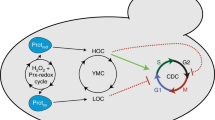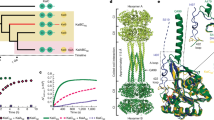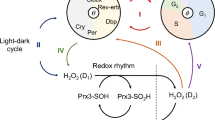Abstract
Cellular life emerged ∼3.7 billion years ago. With scant exception, terrestrial organisms have evolved under predictable daily cycles owing to the Earth’s rotation. The advantage conferred on organisms that anticipate such environmental cycles has driven the evolution of endogenous circadian rhythms that tune internal physiology to external conditions. The molecular phylogeny of mechanisms driving these rhythms has been difficult to dissect because identified clock genes and proteins are not conserved across the domains of life: Bacteria, Archaea and Eukaryota. Here we show that oxidation–reduction cycles of peroxiredoxin proteins constitute a universal marker for circadian rhythms in all domains of life, by characterizing their oscillations in a variety of model organisms. Furthermore, we explore the interconnectivity between these metabolic cycles and transcription–translation feedback loops of the clockwork in each system. Our results suggest an intimate co-evolution of cellular timekeeping with redox homeostatic mechanisms after the Great Oxidation Event ∼2.5 billion years ago.
This is a preview of subscription content, access via your institution
Access options
Subscribe to this journal
Receive 51 print issues and online access
$199.00 per year
only $3.90 per issue
Buy this article
- Purchase on SpringerLink
- Instant access to full article PDF
Prices may be subject to local taxes which are calculated during checkout






Similar content being viewed by others
References
Dunlap, J. C. Molecular bases for circadian clocks. Cell 96, 271–290 (1999)
Woelfle, M. A., Ouyang, Y., Phanvijhitsiri, K. & Johnson, C. H. The adaptive value of circadian clocks; an experimental assessment in cyanobacteria. Curr. Biol. 14, 1481–1486 (2004)
Dodd, A. N. et al. Plant circadian clocks increase photosynthesis, growth, survival, and competitive advantage. Science 309, 630–633 (2005)
Barger, L. K., Lockley, S. W., Rajaratnam, S. M. & Landrigan, C. P. Neurobehavioral, health, and safety consequences associated with shift work in safety-sensitive professions. Curr. Neurol. Neurosci. Rep. 9, 155–164 (2009)
Wijnen, H. & Young, M. W. Interplay of circadian clocks and metabolic rhythms. Annu. Rev. Genet. 40, 409–448 (2006)
Allada, R., Emery, P., Takahashi, J. S. & Rosbash, M. Stopping time: the genetics of fly and mouse circadian clocks. Annu. Rev. Neurosci. 24, 1091–1119 (2001)
Rosbash, M. The implications of multiple circadian clock origins. PLoS Biol. 7, e62 (2009)
Zheng, X. & Sehgal, A. Probing the relative importance of molecular oscillations in the circadian clock. Genetics 178, 1147–1155 (2008)
O’Neill, J. S. et al. Circadian rhythms persist without transcription in a eukaryote. Nature 469, 554–558 (2011)
O’Neill, J. S. & Reddy, A. B. Circadian clocks in human red blood cells. Nature 469, 498–503 (2011)
Hall, A., Karplus, P. A. & Poole, L. B. Typical 2-Cys peroxiredoxins–structures, mechanisms and functions. FEBS J. 276, 2469–2477 (2009)
Wood, Z. A., Poole, L. B. & Karplus, P. A. Peroxiredoxin evolution and the regulation of hydrogen peroxide signaling. Science 300, 650–653 (2003)
Barranco-Medina, S., Lazaro, J. J. & Dietz, K. J. The oligomeric conformation of peroxiredoxins links redox state to function. FEBS Lett. 583, 1809–1816 (2009)
Woo, H. A. et al. Reversible oxidation of the active site cysteine of peroxiredoxins to cysteine sulfinic acid. Immunoblot detection with antibodies specific for the hyperoxidized cysteine-containing sequence. J. Biol. Chem. 278, 47361–47364 (2003)
Lopez-Molina, L., Conquet, F., Dubois-Dauphin, M. & Schibler, U. The DBP gene is expressed according to a circadian rhythm in the suprachiasmatic nucleus and influences circadian behavior. EMBO J. 16, 6762–6771 (1997)
Johnson, C. H., Mori, T. & Xu, Y. A cyanobacterial circadian clockwork. Curr. Biol. 18, R816–R825 (2008)
Nakajima, M. et al. Reconstitution of circadian oscillation of cyanobacterial KaiC phosphorylation in vitro . Science 308, 414–415 (2005)
Dvornyk, V., Vinogradova, O. & Nevo, E. Origin and evolution of circadian clock genes in prokaryotes. Proc. Natl Acad. Sci. USA 100, 2495–2500 (2003)
Whitehead, K., Pan, M., Masumura, K., Bonneau, R. & Baliga, N. S. Diurnally entrained anticipatory behavior in archaea. PLoS ONE 4, e5485 (2009)
Lakin-Thomas, P. L. Transcriptional feedback oscillators: maybe, maybe not. J. Biol. Rhythms 21, 83–92 (2006)
Reddy, A. B. & O’Neill, J. S. Healthy clocks, healthy body, healthy mind. Trends Cell Biol. 20, 36–44 (2009)
Young, M. W. & Kay, S. A. Time zones: a comparative genetics of circadian clocks. Nature Rev. Genet. 2, 702–715 (2001)
Young, M. W. The molecular control of circadian behavioral rhythms and their entrainment in Drosophila . Annu. Rev. Biochem. 67, 135–152 (1998)
Allada, R., White, N. E., So, W. V., Hall, J. C. & Rosbash, M. A mutant Drosophila homolog of mammalian clock disrupts circadian rhythms and transcription of period and timeless . Cell 93, 791–804 (1998)
Hardin, P. E. The circadian timekeeping system of Drosophila . Curr. Biol. 15, R714–R722 (2005)
Dunlap, J. C. & Loros, J. J. How fungi keep time: circadian system in Neurospora and other fungi. Curr. Opin. Microbiol. 9, 579–587 (2006)
Aronson, B. D., Johnson, K. A., Loros, J. J. & Dunlap, J. C. Negative feedback defining a circadian clock: autoregulation of the clock gene frequency . Science 263, 1578–1584 (1994)
Granshaw, T., Tsukamoto, M. & Brody, S. Circadian rhythms in Neurospora crassa: farnesol or geraniol allow expression of rhythmicity in the otherwise arrhythmic strains frq10, wc-1, and wc-2 . J. Biol. Rhythms 18, 287–296 (2003)
Lakin-Thomas, P. L. & Brody, S. Circadian rhythms in microorganisms: new complexities. Annu. Rev. Microbiol. 58, 489–519 (2004)
Corellou, F. et al. Clocks in the green lineage: comparative functional analysis of the circadian architecture of the picoeukaryote ostreococcus. Plant Cell 21, 3436–3449 (2009)
Mas, P., Alabadi, D., Yanovsky, M. J., Oyama, T. & Kay, S. A. Dual role of TOC1 in the control of circadian and photomorphogenic responses in Arabidopsis . Plant Cell 15, 223–236 (2003)
Ditty, J. L., Canales, S. R., Anderson, B. E., Williams, S. B. & Golden, S. S. Stability of the Synechococcus elongatus PCC 7942 circadian clock under directed anti-phase expression of the kai genes. Microbiology 151, 2605–2613 (2005)
Pulido, P. et al. Functional analysis of the pathways for 2-Cys peroxiredoxin reduction in Arabidopsis thaliana chloroplasts. J. Exp. Bot. 61, 4043–4054 (2010)
Yoshida, Y., Iigusa, H., Wang, N. & Hasunuma, K. Cross-talk between the cellular redox state and the circadian system in Neurospora . PLoS ONE 6, e28227 (2011)
Wang, M. et al. A universal molecular clock of protein folds and its power in tracing the early history of aerobic metabolism and planet oxygenation. Mol. Biol. Evol. 28, 567–582 (2011)
Nathan, C. & Ding, A. SnapShot: reactive oxygen intermediates (ROI). Cell 140, 951–951.e2 (2010)
Zelko, I. N., Mariani, T. J. & Folz, R. J. Superoxide dismutase multigene family: a comparison of the CuZn-SOD (SOD1), Mn-SOD (SOD2), and EC-SOD (SOD3) gene structures, evolution, and expression. Free Radic. Biol. Med. 33, 337–349 (2002)
Mulholland, P. J., Houser, J. N. & Maloney, K. O. Stream diurnal dissolved oxygen profiles as indicators of in-stream metabolism and disturbance effects: Fort Benning as a case study. Ecol. Indic. 5, 243–252 (2005)
Venkiteswaran, J. J., Wassenaar, L. I. & Schiff, S. L. Dynamics of dissolved oxygen isotopic ratios: a transient model to quantify primary production, community respiration, and air-water exchange in aquatic ecosystems. Oecologia 153, 385–398 (2007)
Bamforth, S. S. Diurnal changes in shallow aquatic habitats. Limnol. Oceanogr. 7, 348–353 (1962)
Ochoa, D. & Pazos, F. Studying the co-evolution of protein families with the Mirrortree web server. Bioinformatics 26, 1370–1371 (2010)
Peixoto, A. A., Campesan, S., Costa, R. & Kyriacou, C. P. Molecular evolution of a repetitive region within the per gene of Drosophila . Mol. Biol. Evol. 10, 127–139 (1993)
McIntosh, B. E., Hogenesch, J. B. & Bradfield, C. A. Mammalian Per-Arnt-Sim proteins in environmental adaptation. Annu. Rev. Physiol. 72, 625–645 (2010)
Rutter, J., Reick, M. & McKnight, S. L. Metabolism and the control of circadian rhythms. Annu. Rev. Biochem. 71, 307–331 (2002)
Rutter, J., Reick, M., Wu, L. C. & McKnight, S. L. Regulation of clock and NPAS2 DNA binding by the redox state of NAD cofactors. Science 293, 510–514 (2001)
Shima, S., Thauer, R. K. & Ermler, U. Hyperthermophilic and salt-dependent formyltransferase from Methanopyrus kandleri . Biochem. Soc. Trans. 32, 269–272 (2004)
Declercq, J. P. et al. Crystal structure of human peroxiredoxin 5, a novel type of mammalian peroxiredoxin at 1.5 Å resolution. J. Mol. Biol. 311, 751–759 (2001)
Schröder, E. et al. Crystal structure of decameric 2-Cys peroxiredoxin from human erythrocytes at 1.7 Å resolution. Structure 8, 605–615 (2000)
Xu, Y., Mori, T. & Johnson, C. H. Cyanobacterial circadian clockwork: roles of KaiA, KaiB and the kaiBC promoter in regulating KaiC. EMBO J. 22, 2117–2126 (2003)
Pazos, F. & Valencia, A. Similarity of phylogenetic trees as indicator of protein-protein interaction. Protein Eng. 14, 609–614 (2001)
Gould, P. D. et al. Delayed fluorescence as a universal tool for the measurement of circadian rhythms in higher plants. Plant J. 58, 893–901 (2009)
Rosato, E. & Kyriacou, C. P. Analysis of locomotor activity rhythms in Drosophila. Nature Protocols 1, 559–568 (2006)
Reddy, A. B. et al. Circadian orchestration of the hepatic proteome. Curr. Biol. 16, 1107–1115 (2006)
Whitehead, K., Pan, M., Masumura, K., Bonneau, R. & Baliga, N. S. Diurnally entrained anticipatory behavior in archaea. PLoS ONE 4, e5485 (2009)
Mori, T., Binder, B. & Johnson, C. H. Circadian gating of cell division in cyanobacteria growing with average doubling times of less than 24 hours. Proc. Natl Acad. Sci. USA 93, 10183–10188 (1996)
Yoo, S. H. et al. PERIOD2::LUCIFERASE real-time reporting of circadian dynamics reveals persistent circadian oscillations in mouse peripheral tissues. Proc. Natl Acad. Sci. USA 101, 5339–5346 (2004)
House, S. B., Thomas, A., Kusano, K. & Gainer, H. Stationary organotypic cultures of oxytocin and vasopressin magnocellular neurons from rat and mouse hypothalamus. J. Neuroendocrinol. 10, 849–861 (1998)
Hastings, M. H., Reddy, A. B., McMahon, D. G. & Maywood, E. S. Analysis of circadian mechanisms in the suprachiasmatic nucleus by transgenesis and biolistic transfection. Methods Enzymol. 393, 579–592 (2005)
Maywood, E. S. et al. Synchronization and maintenance of timekeeping in suprachiasmatic circadian clock cells by neuropeptidergic signaling. Curr. Biol. 16, 599–605 (2006)
Davis, R. H. Neurospora: Contributions of a Model Organism (Oxford Univ. Press, 2000)
Merrow, M., Brunner, M. & Roenneberg, T. Assignment of circadian function for the Neurospora clock gene frequency. Nature 399, 584–586 (1999)
Olmedo, M. et al. A role in the regulation of transcription by light for RCO-1 and RCM-1, the Neurospora homologs of the yeast Tup1–Ssn6 repressor. Fungal Genet. Biol. 47, 939–952 (2010)
Woo, H. A. & Rhee, S. G. in Methods in Redox Signaling (ed. Das, D. ) Ch. 4 19–23 (Mary Ann Liebert, 2010)
Ishiura, M. et al. Expression of a gene cluster kaiABC as a circadian feedback process in cyanobacteria. Science 281, 1519–1523 (1998)
Qin, X. et al. Intermolecular associations determine the dynamics of the circadian KaiABC oscillator. Proc. Natl Acad. Sci. USA 107, 14805–14810 (2010)
Xu, Y. et al. Intramolecular regulation of phosphorylation status of the circadian clock protein KaiC. PLoS ONE 4, e7509 (2009)
Stork, T., Laxa, M., Dietz, M. S. & Dietz, K. J. Functional characterisation of the peroxiredoxin gene family members of Synechococcus elongatus PCC 7942. Arch. Microbiol. 191, 141–151 (2009)
Xu, Y., Mori, T. & Johnson, C. H. Cyanobacterial circadian clockwork: roles of KaiA, KaiB and the kaiBC promoter in regulating KaiC. EMBO J. 22, 2117–2126 (2003)
Ochoa, D. & Pazos, F. Studying the co-evolution of protein families with the Mirrortree web server. Bioinformatics 26, 1370–1371 (2010)
Pazos, F. & Valencia, A. Similarity of phylogenetic trees as indicator of protein–protein interaction. Protein Eng. 14, 609–614 (2001)
Oster, H., Damerow, S., Hut, R. A. & Eichele, G. Transcriptional profiling in the adrenal gland reveals circadian regulation of hormone biosynthesis genes and nucleosome assembly genes. J. Biol. Rhythms 21, 350–361 (2006)
Acknowledgements
This work was primarily supported by the Wellcome Trust (083643/Z/07/Z and 093734/Z/10/Z), the European Research Council (ERC Starting Grant No. 281348, MetaCLOCK), and EMBO Young Investigators Programme, as well as the Medical Research Council Centre for Obesity and Related metabolic Disorders (MRC CORD), and the National Institute for Health Research (NIHR) Cambridge Biomedical Research Centre. C.P.K. and M.H.H. acknowledge European Commission grant EUCLOCK (no. 018741) and Biotechnology and Biological Sciences Research Council (BBSRC) grant BB/C006941/1. SynthSys is funded by BBSRC and Engineering and Physical Sciences Research Council (EPSRC) award BB/D019621 to A.J.M. and others. N.S.B. was supported by ENIGMA, US Department of Energy, under contract no. DE-AC02-05CH11231, and by a grant from the National Institutes of Health (NIH; P50GM076547). C.H.J. was supported by the NIH (R01GM088595, R01GM067152 and R21HL102492). M.M. was supported by the Netherlands Organisation for Scientific Research (NWO; Dutch Science Foundation VICI award and Open Programma) and the University of Groningen (Rosalind Franklin Fellowship Program). We thank M. Jain, G. O’Neill and J. Chambers for discussion about the manuscript, and S. G. Rhee, F. Rouyer and R. Stanewsky for the gifts of antisera.
Author information
Authors and Affiliations
Contributions
A.B.R. and J.S.O. conceived and designed the experiments, and wrote the manuscript. R.S.E., E.W.G., G.v.O., M.O., X.Q., Y.X., Y.Z., M.P., U.K.V., K.A.F. and E.S.M. performed experiments. M.H.H., N.S.B., C.H.J., M.M., A.J.M. and C.P.K. provided reagents. R.S.E., E.W.G., G.v.O., M.O. and Y.Z. contributed equally to this work.
Corresponding authors
Ethics declarations
Competing interests
The authors declare no competing financial interests.
Supplementary information
Supplementary Information
This file contains Supplementary Tables 1-9, Supplementary Figures 1-10 and additional references. (PDF 1924 kb)
Rights and permissions
About this article
Cite this article
Edgar, R., Green, E., Zhao, Y. et al. Peroxiredoxins are conserved markers of circadian rhythms. Nature 485, 459–464 (2012). https://doi.org/10.1038/nature11088
Received:
Accepted:
Published:
Issue Date:
DOI: https://doi.org/10.1038/nature11088



